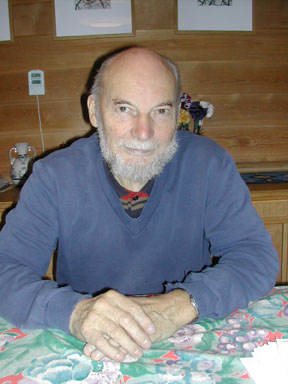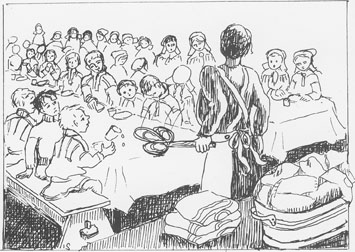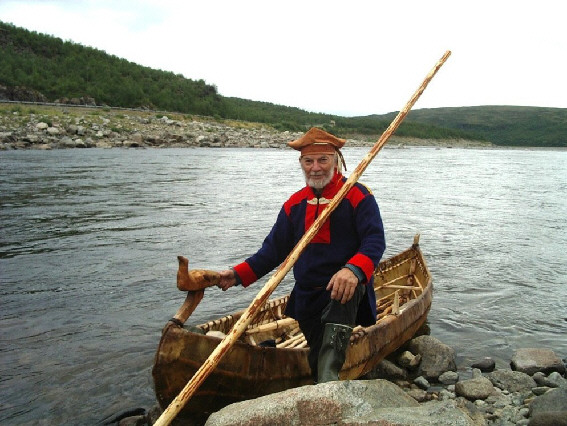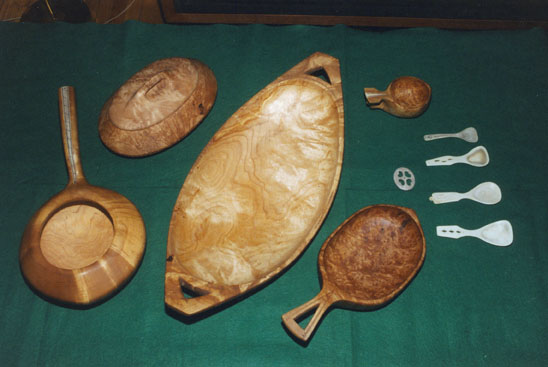 Sámegillii
Sámegillii  På norsk
På norsk
Article in the book Sami school history 1. Davvi Girji 2005.

Jon Ole Andersen, Kárášjohka, 2003 |
Jon Ole Andersen was born in 1932 in Horbmá in what
at the time was called Polmak commune, now Deatnu / Tana, and started school in
1939. In this article he is narrating of his own experiences from
Polmak school, and how he without any formal education has been able to
reach as far as becoming sensor for majors exams in duodji.
Jon Ole Andersen has worked as caretaker and preparator in museums, and for that last 15 years he has been executant of duodji and full-time artist. His works have been to many exhibitions and he has gained various distinctions for them. |
My time at school? It was so sad that I'll never forget about it.
First I'd like to describe how the situation was before I started school. I grew up in Horbmá, which is about 4-5 km distance from Polmak school. My parents were peasants, we had a few cows and sheep. And in addition we went fishing, gathered berries and went hunting. People were good at managing with few means, but still there were poverty everywhere. There were 9 farms in Horbmá at the time, and there were very many children. In some farms there were more than 10 children, but we were only six in our house. All the children used to play together, and it was a very good milieu.
My father died when I was 11 years old, and left my mother alone with the responsibility for a big group of children.
At that time the Sami language was the only heard in
Horbmá. In Buolbmát (Polmak) there weren't many Norwegian speakers,
there were the district sheriff, the postman, the shopkeeper and the teachers.
There weren't any Finish
speakers at that time. We had a few relatives at the Finish side of the
border, but we only spoke Sami with them. My mother knew a little
Norwegian, as she had been working as a maid servant in Vardø, but my
father knew very little Norwegian. Both my parents could read Sami, but
they couldn't read Norwegian. They used to read Nuorttanástte (Christian
newspaper in Sami language). My mother was able to explain us the meaning of a
few Norwegian words.
When I started school there weren't any roads in
the area yet. We had to follow the path during the summertime, and the
river Tana during the winter. It was difficult when we were going to
school
in the springtime. Some places the ground was very clayey, and we had
to climb further up in the hillside. I had a brother who was one year
older than me, and who already had been to school for a year and was
familiar with the life in the boarding school. But I didn't want to
go there myself, although there were many children I knew. My mother
followed me to school, but I didn't want to stay there, and cried for
the rest of that day.
It was very difficult at school. In the classroom Norwegian was the only spoken language, and I didn't understand a word. We didn't dare to speak when we entered the classroom. We weren't allowed to speak Sami, and we didn't know Norwegian. We sat there listening, although we couldn't understand a word. It lasted a couple of years before I started to pick up a few things. Of course, the ones who knew a little Norwegian beforehand got a greater benefit from the teaching much faster.
Most of the teachers came from the south of Norway. I think the teachers must have found the situation very difficult as well. They didn't stay for a long time in our school. Most of them just stayed for a year, and never returned again.
Only one of the teachers at the school spoke Sami. His name was Hans Baukop, and he came from Porsanger. He was a very good teacher and a witty guy. He told us fairytales and read religious texts in Sami to us. When he told fairytales he was very lively and made use of all his body. Sometimes he'd also use his voice in such a strong manner that other teachers would come by to ask what was going on. He was a very good teacher to us. But he wasn't allowed to speak Sami, the rules were very strict, not just for the pupils, but also for the teachers. I've learned later that other teachers looked down on him because he was Sami, and that he had trouble with the school authorities because he spoke Sami in school. But at the time we didn't know anything of all that. He didn't live in the boarding school. He had a farm at the other side of the river.
There was another teacher who knew Sami, Jens Eriksen, but he didn't dare to speak anything but Norwegian.
In those days they built boarding schools in places where there weren't many people in order to be able to Norwegianize the children better. We were in the boarding school for 4-6 weeks at a time, then we spent a couple of weeks at home before we returned. We used to eat in a big dining hall there, with 12 pupils at each table. The teacher used to eat there too, but they got better food than us. Some pupils, like the children of the shopkeeper, used to get more cold cuts than the rest of us. We'd normally just get bread and butter. It taught us that there's differences between the rich and the poor, or "class distinctions" (klasseskilje) as one says in Norwegian.
The maids in the boarding school used to clean our
clothes, and at supper they'd hold up the clean clothes and call up,
and we'd have to go up and get them. Because people were poor they had
made clothes from what they could get hold of. One of the boys had a
pair of underpants which his mother had sown from a German flour sack,
where one could see the swastika. When the girl called "whose is this?"
he didn't' answer with a single word.
 |
In the boarding school the freshly
cleaned clothes were handed out in front of everybody. Not all of us were happy
to have their underwear displayed in public.
(Drawing by Inger Seierstad, from the book Boahtte-áigge-bárdni ja Stuora-Ovllá.) |
In the beginning the maids of boarding school were all Norwegian speakers. During the last years maids who spoke Sami were accepted to a greater extent also, and I remember that we had a couple of Sami speaking maids during the last years. Their presence allowed for more speaking in Sami within the school. The housekeepers were rivgus (non-sami women), and some of them were very vicious. There were many of them during the time I went to school, I don't remember any other names but "miss Lampe".
During the war there were rations, one couldn't just go to
the shop and buy for instance flour. The "supply assembly" distributed
the amount we were allowed to buy. We pupils had to carry this to the
school, 5 kg each. I remember that it was very heavy as a 8-9 year old
boy to carry sacks of flour for 5 km when there wasn't even a proper
road.
 |
The hall for woodwork at Polmak
school, where Jon Ole Andersen got his first training in woodwork, and later
also taught others. (Photo: Ivar Skotte) |
The Germans were supposed to burn Polmak too in the autumn 1944. They burned everything below Álletnjárga and Horbmá, and they burned some outhouses in Polmak too. But then they got in an extreme hurry. An old man had been in the mountains and had seen a Russian captive who had escaped. So he was able to tell the Germans he had seen a Russian a couple of kilometers away. But because they didn't understand each other well, the Germans understood that there were Russian soldiers there. Therefore they ran away and didn't get around to burn everything. We were already prepared to evacuate. We had lead the horses out in the forrest, dug things down in the ground and sunk the riverboats. But suddenly the Germans disappeared, and we were able to continue to live at home.
I frequented the confirmation school in 1948. The school was held every other year, therefore I attended with my brother, who was a year older. We were able to walk to church, but there were a lot of children who had to live in the houses of acquaintances during the time the confirmation school lasted. The priest spoke only Norwegian, and we were given texts which we had to learn by heart. Oh, it was hard to learn so much in a strange language! The school only lasted for four weeks. The confirmation took place during the easter. I remember that it was completely crowded in the small church, and it became very warm. It happened that a youth fainted and they had to carry him out. It was very nevre-wracking with such a terrible exam, almost like passing a doctors degree.
After finishing this we didn't want more schooling.
Some years later we received a letter addressed to all Sami homes with
the offer to attend the Sami folk high school. I don't remember where the
letter came from, if it was from DSF or the superintendent of school. I
got this offer as well, but I thought I didn't dare to go, I didn't
learn that much at school. So in the end I didn't go. Only some people
from my area went.
I had learned some woodwork during childhood already. A man
who was married to my aunt, Jávrre-Juhán, lived close to Buobmátjávri.
He was a very skillful craftsman, and
he made all sorts of things; sleighs, harness and
lots of other things. When I finished school I started to work as a
carpenter. At the time, just after the war,<
there were a lot of construction work to be done.
Everybody who were able were working with construction. In the
beginning I worked with the others, and after some time I started to do
construction work on my own.
I worked as a carpenter in 1962-63 during the construction of the new boarding school and teachers buildings in Buolbmát. When I was offered the job as caretaker at Polmak school, I took it. Meanwhile working there I was also able to attend a course in duodji in Seida, which was held by Lauri Keskitalo. I made my first knife in this course, and from then on I started to work with duodji myself.
I wanted to work as a woodwork teacher, but it wasn't easy to enter the teachers college without any formal education. I applied for the governmental arts and crafts teachers education in 1965. Both the headmaster at Polmak school and the Sami consultant in Finmark wrote recomendations, but to no avail. The reply they gave me was that they had many applicants and had to give priority to the ones who had a formal education. And my dream of a teachers education ended with that.
When the new museum was built in Kárášjohka in 1971 (Sámiid vuorká-dávvirat
- The Sami collections), I got
a position there, as caretaker and
preparatory. It was a very good workplace for me. I got
to know a lot of people, also from Sweden and Finland. Meanwhile I was
working in the museum I was also able to attend many courses, for technical
conservation, conservation of textiles, securing of museums and others.
I had a leave of absence in 1981-82 from the museum, and
worked as a teacher in the Sami folk high school. I taught duodji,
gymnastics and supported social initiatives.
But I didn't do any theoretical teaching. I worked very
long days, and often didn't return home before the students had gone to
bed.
I have been to duodji courses in Jokkmokk a couple of
times. They were very competent there. I used to conduct duodji courses
myself while I was working in the museum. After teaching in this way
for about ten years, the idea of working full-time with duodji was
formed. So I quit my position at the
museum, sold the old house I had in Horbmá and built a combined private house
and workshop here in Karasjok. If I can't
make my living by doing duodji, an old carpenter will always find
something to do, I thought. And
from 1985 and onwards I have been working as duojár.
It was of great help for me to become a member of Sámi dáiddáriid searvvi (association for Sami artist). It gave me access to participate in exhibitions, which made my name more known, and made it easier to sell the things I made. I've managed about as well economically as when I was permanently employed.
 |
Among the biggest of the many duodji
products Jon Ole has made are boats made from hides and wood, after
models from rock carvings. One of them is to be found in the Alta
museum now. And here he is on a test drive in Tana with boat number 3. (Photo: Áššu) |
Craft certificate in duodji? Yes, I could have had that, but when the craft certificate system was introduced, I thought; "now I have lived for such a long time and managed without, so I think I will manage with what I have learned in life. And if they don't accept me without the paper." That's how stubborn I've been. But I've been censor for many years now when others have done the craft certificate. I am part of the board of education for duodji in Finnmark county. I was even censor for duodji major when Gunvor Guttorm did her exam.
In the seventies there was a huge activity here. One can not expect the ones who were active at that time to still continue, but I do not know how the recruiting for the Sami associations is nowadays. One could expect the youth to be more involved. Of course there is organizations for youths, but locally there is very low activity. Ole Henrik Magga said that when we Sami are silent, the authorities can do anything they like to us.
 |
A selection of the duodji products
made by Jon Ole Andersen. |
I have managed in life, despite that all the schooling I
got was 7 years in a foreign language. As the time has passed I have
learned to calculate and read. I don't read fast, but I manage. I read Sami
about as good as
Norwegian now. I have learned to read Sami after they started to
publish Sami newspapers. Sometimes I
have to read books in Sami as well. I do not read
them fast, but I am not in a hurry either. It would have been good to
be able to write better. When I have worked with Sami associations and such, I
have thought
that if I had more schooling I would have been able to work with
anything.
Still I have to say that my life has been good. I have
lived in peace, and when I pass on I can think that no one has had to
suffer because of me. I have many friends in
many places. And in that sense it has been very good.
| Synnøve Persen has written a book about Jon Ole Andersen and his
art.
The book, which is called Muora ii galgga sojahit eambbo go gierdá,
was published by the publishing house Iđut in 1999. In this book Jon
Ole also tells some things about the school, and we recite a couple of
extracts from this book:
The only teacher who spoke Sami to us were Hans Baukop. He was very special. He told us about the power of God, and that once when he was crossing the ice and fell down in a hole in the ice, he screamed: "Father God, save me!" and afterwards he was able to walk on the water until he reached the shore. We believed him, of course, and when the spring came, we had to try ourselves. It wasn't a great success. ... In those days the school used to award a price, 50 øre, to the students which did best when it came to Norwegian. It gave us the feeling that the ones who didn't know Norwegian wasn't worth anything. The impact was great, also for the ones who never got this reward. We were stupid. And that feeling has rooted in people for life. Once I think there was a Sami child who got this reward, otherwise it was only given to the Norwegian speaking children. ... My eldest brother and I had to attend the school in turns, because our mother was alone with the children. In those days there were no help to get, except the one you could get in the village. There wasn't any kind of social help like today. In school they accepted this organization because things were the way they were. Our job was to hew wood, fetch water and other daily routines. We did this for a year, and afterwards we went to school together. Our three younger sisters grew older, and were able to help our mother. |